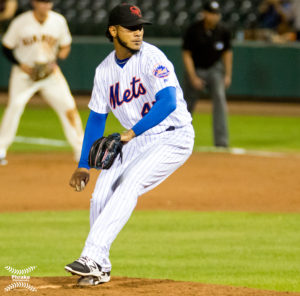#13 Marcos Molina
Ht: 6’3″ Wt: 188 Level: High-A St. Lucie Mets (2015)
B/T: R/R Age: 3/8/95 (21) Age Dif: -2.9 (2015)
Acquired: Signed as International Free Agent for $100,000 (January 2012)
Last year: 9
2015 MiLB Statistics: 1-5, 4.57 ERA, 8 G, 7 GS, 41.1 IP, 1.452 WHIP, 7.8 K/8
2016 AFL Statistics: 0-0, 3.78 ERA, 7 G, 2 GS, 16.2 IP, 1.380 WHIP, 4.3 K/9
When the Mets signed Molina as a 16-year old out of the Dominican Republic, there were a few things that stood out with him. First, he had a strong work ethic and an eagerness to get out onto the field every day. Second, Molina already showed good velocity on his fastball with an intriguing changeup. Third, Molina had an ability to repeat his delivery.
Ultimately, that was the problem with Molina.
Molina’s delivery was just terrible from a mechanics standpoint. He generated next to nothing from his lower half due in large part to the extremely short stride he took. His stride was akin to the stride an infielder makes throwing the ball back to the pitcher after an out is recorded. This meant the entirety of the velocity he generated was from his arm. That was another problem. Molina short armed the ball with violent action. These mechanics were not a red flag. They were a fog horn that Molina was a pitcher likely to suffer from a major arm injury.
That injury would happen in 2015. On the one hand, it was devastating as Molina was coming off a breakout season in Brooklyn. In 2014, Molina made 12 starts going 7-3 with a 1.78 ERA, 0.842 WHIP, and a 10.8 K/9. During that season, Molina was gaining velocity on his fastball, and he was improving his secondary pitches. He was outclassing the competition. He was getting notice everywhere by different scouting websites. Ultimately, this is not the time you want a major injury.
On the other hand, the injury did present him with an opportunity. Odd as it may sound, especially coming off a great year, it really was a matter of time before Molina’s arm was going to break. His mechanics were that poor. Being shut down during like he was presented an opportunity for Molina to improve his mechanics. Unfortunately, that opportunity came because Molina tore his UCL.
Molina had undergone Tommy John surgery in October 2015. A year later, Molina was at the step in his rehabilitation process where he could once again take the mound. With Molina being eligible for the Rule 5 Draft, the Mets made the decision to let him pitch in the Arizona Fall League.
During Molina’s seven appearances in the Arizona Fall League, we did see a pitcher with better mechanics. Molina had a longer stride, which in turn allowed him to get a better arm path to the plate. With that, we saw Molina’s fastball velocity range from the high 80s to the mid 90s. We also saw him throw his change-up, and a slider. It’s too early to get a read on any of these pitches as he is still theoretically in the rehabilitation process, and he is still working on his mechanics.
And yes, Molina still needs to work on his mechanics. While his stride is an improvement, it is still too short. In turn, he is still over-relying on his arm to generate the arm speed on his pitches.
At this point, we do not know what his mechanics will ultimately look like. It’s possible this was just the first step in the process. It’s also possible, this is how Molina is comfortable pitching, and he is going to revert back to the stride he had pre-surgery. Ultimately, Molina’s mechanics are going to determine exactly what he is as a pitcher.
If Molina cleans up the mechanics, he has the potential to be a front line starter at the major league level. With his fastball and change-up, he is not only capable of a high number of strikeouts, but he is also able to induce a number of ground balls. He also uses a slider, a pitch the Mets organization teaches well, that could be difference between being a starter and reliever.
However, without a change in mechanics, Molina is at risk for yet another arm injury. If so, he would be better off as a reliever. It’s exactly what the Mets did with Hansel Robles, who had similar mechanics to those Molina has now. However, it should be noted Molina’s secondary pitches are better developed at this stage in his professional career.
We will know more about what exactly Molina will be once we see him pitch this year. Fortunately for him, he is eventually going to work with Glenn Abbott in Binghamton and Frank Viola in Las Vegas. Abbott and Viola have done a good job helping the Mets pitching prospects clean up some of their mechanical issues. Hopefully, they will be able to do the same for Molina.
2017 Outlook
Coming off Tommy John surgery, the Mets standard operating procedure will be to cap his innings. This could lead to the team either easing him into the season by starting at a lower level or in an extended Spring Training for rehabilitation purposes. It is also possible the Mets let him report on Opening Day and shut him down at some point in August.
While we do not know where Molina will start the year, he should spend a significant portion of the 2017 season in Binghamton after starting with St. Lucie.
2017 MMN TOP 100 PROSPECTS



Remains one of the most intriguing prospects in their farm system.
This kid has the opportunity to shine if he improves his mechanics in A/AA and emerge as a viable front line starter in 2017. Let’s hope he listens to his coaches and make a successful change!